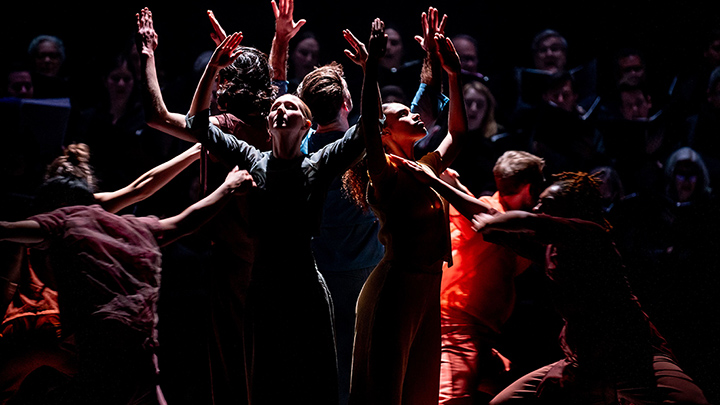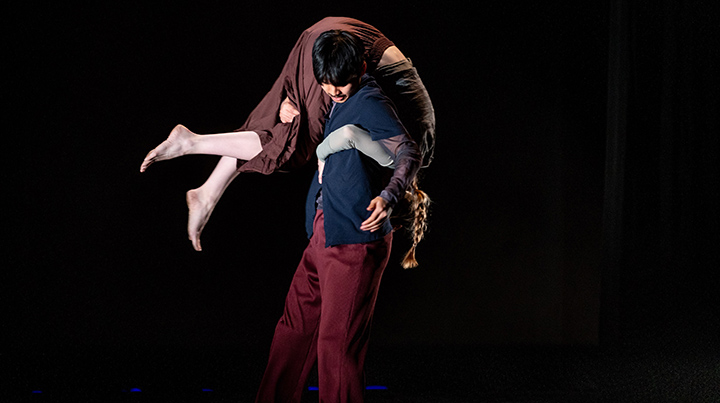So late last month I approached To My Arms/Restore, two pieces choreographed by Doug Varone to numerous Handel vocal works with hope, and the evening turned out to be an unusually invigorating baroque/modern mashup.
The apex for modern dance to baroque music must be Mark Morris’s glorious L’Allegro, il Penseroso ed il Moderato which I have seen at least five times since its US premiere in 1990, and it never fails to match Handel’s sublime music and Milton’s exquisite poetry. After many years, it’s available on video, an essential item for anyone’s library.
I’ve somehow missed Paul Taylor’s Handel ballets Aureole and Airs, but I have great affection for Balanchine’s divine Bach Concerto Barocco…

… as well as Peter Anastos’s delicious Trockadero parody Go for Barocco!

If not inexhaustible masterpieces like the Morris or Balanchine, Varone’s new pair made me want to see much more of his choreography. Going in I thought I wasn’t familiar with the veteran’s work as I’d never attended a performance by his company. But I realized that I’d encountered him at the Met where he made the Dance of the Seven Veils for the FlimmSalome, as well as the dances in Francesca Zambello’s Les Troyens. He was also involved with The Amiercan Tragedy and the most recent run of the John Dexter Stravinsky triple-bill for which he directed Le Sacre du Printemps.
Presented at NYU’s Skirball Center, Varone’s new works were a joint venture between Varone’s dance company and MasterVoices, the large choral enterprise conducted by Ted Sperling who also led New York Baroque Incorporated, a young period-instrument ensemble. The choreographer’s relationship with MasterVoices dates back to another baroque project, their 2016 production of Purcell’s Dido and Aeneas with Kelli O’Hara and Victoria Clark.
To My Arms featured eleven Handel arias and duets performed by five vocal soloists. To my surprise, only a few were among the composer’s greatest hits, like “V’adoro pupille” from Giulio Cesare and “Ombra mai fu” from Serse. Varone also chose several shortish ariosos rather than long ABA’ da capo arias; it was a delight to encounter excerpts from less familiar works like Scipione, Alexander Balus and Teseo.
Rather than mimic baroque rhythms or vocal lines, Varone intuitively captured the spirit of each selection. Most often the dances featured couples or throuples struggling with achieving intimacy. Two of the most vivid featured same-sex couples, in particular the male couple in the “V’adoro pupille” sung with blunt eagerness by tenor John Easterlin. Unfortunately, it wasn’t the only selection sung by the “wrong” voice.
All of Varone’s choices were composed by Handel for soprano and alto voices. Presumably to make use of the tenor and bass needed for the Dixit Dominius used for Restore, several were transposed to both the singer’s and Handel’s disadvantage. In particular, Cleopatra’s moving “Convey Me to some Peaceful Shore” from Alexander Balus became inordinately heavy in bass Benjamin Howard’s rendering. The exuberant chaos arriving via the bravura Scipione soprano aria “Scoglio d’immota fronte” featured all eight dancers and worked thrillingly, while other numbers had lovely, intriguing touches like the poignant female solo to “Ombra mai fu” (well sung by countertenor Jake Ingbar) that also included a mysterious crawling male dancer.
After intermission, Restore was set to Nico Bentley’s Handel Remixed, his contemporary reinterpretation of Handel’s Dixit Dominus, his thrilling early work, with a 21st century beat. When I saw nearly one hundred members of MasterVoices behind a scrim, I feared that Handel’s dazzlingly complex choral writing would be turned into a muddy mess, but Sperling achieved nearly miraculous clarity as his vocal and instrumental forces switched seamlessly between “real” Handel and Bentley’s inventive riffs.
Where To My Arms consisted of sections where the number of dancers varied from two to eight, Restore consistently used all eight in a driving, percussively disturbing unity. Bentley’s musical additions added rather than detracted from the Dixit handily serving to point up that work’s forward-sounding inventiveness.
If this review suffers from a lack of specificity, it’s not entirely my doing. Upon arriving at the entrance of the Skirball auditorium, I was informed that there were no printed programs—ugh! Information was only available via a dreaded QR code randomly displayed around the lobby. But, of course, internet service in the auditorium was all but impossible.
Eager to learn about the music being performed, I trudged upstairs where I was assured service was better—it was…sporadically. I hurriedly scanned the list of arias and duets, but that program now seems to be unavailable, so I have only my single screenshot that I took before the evening began to refer to.
The sympathetic theater manager explained that unpredictable funding prevents Skirball from offering programs, but wouldn’t at least a single xeroxed page listing dancers, singers, instrumentalists and musical numbers have been possible? I wonder how many in the young and enthusiastic crowd were familiar with Teseo’s tender duet or the old chestnut “Care selve”?
I salute sopranos Liz Lang and Emily Donato who sang beautifully though it was difficult to discern in the darkened pit area who performed which selection. And a big bravi for their grace and stamina to the marvelous dancers—and I apologize in advance to the one I omit since the Varone website only lists seven of the eight I saw: Courtney Barth, Bradley Beakes, Jake Bone, Joniece “Jojo” Boykins, Daeyana Moss, Thryn Sason, and Ryan Yamauchi.
Photo Credit: Greg Kessler







Comments